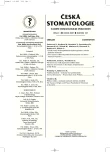Influence of Corrosion on the Origin of Pigmentation of Soft Tissue
Authors:
M. Poddaná 1; L. Joska 1; Z. Venclíková 2
Authors‘ workplace:
Ústav kovových materiálů a korozního inženýrství, VŠCHT, Praha
vedoucí prof. Ing. P. Novák, CSc.
1; Výzkumný ústav stomatologický, Praha
ředitelka prof. MUDr. J. Dušková, DrSc.
2
Published in:
Česká stomatologie / Praktické zubní lékařství, ročník 107, 2007, 1, s. 10-13
Overview
Summary:
In some patients, a blue-grey stained areas (pigmentation) developed after a certain period of time in the area of tooth crown. The paper infers the mechanism of pigmentation development, which is based on corrosion processes of materials used in the tooth reconstruction. In order to determine the conditions to which metal materials are exposed in vivo, oxidation-reduction potentials and pH of saliva and sulcular fluid were measured. The pH of saliva was in the range of 4.8 – 7.8 and that of sulcular fluid was 6.3 – 7.8. The oxidation-reduction potentials reached the values of 0.109-0.432 V/SHE in saliva and 0.149-0.344 in sulcular fluid. The analysis of extracted prosthetic-treated teeth demonstrated existence of crevice between the crown and tooth tissue, which enable the oral electrolyte to reach the post-core. A laboratory study demonstrated the possibility of releasing silver from amalgam and the Koldan alloy, materials used in practice in construction of post-cores, into model saliva samples in the form of soluble corrosion products. The rate of this process was in the range of 0.35-1.11 μg/cm2 per day. In the space between the crown and tooth, other corrosion mechanisms may take part which follow to the increase of corrosion agressiveness of the environment. Simulation of this influence demonstrated that the increased concentration of chloride and thiocyanate ions increases the corrosion rate of low-copper amalgam and the Koldan alloy, the change of corrosion behavior in the higher-copper amalgam proved to be unsubstantial. The study demonstrated that the release of soluble corrosion products of silver in the oral cavity environment may occur. Their transport into the adjacent soft tissues and deposition in the form of insoluble substances may result in the development of pigmentations.
Key words:
silver alloy – dental amalgam – silver release – pigmentation – corrosion
Labels
Maxillofacial surgery Orthodontics Dental medicineArticle was published in
Czech Dental Journal

2007 Issue 1
Most read in this issue
- Internal Granuloma – Present State of the Problem
- What is the Silicon Matrix?
- Direct Applications of Fiber. Composites Substitution of Missing Frontal Teeth
- The Causes of Origin and Present Possibility for Treatment of Alveolitis (A Review)
